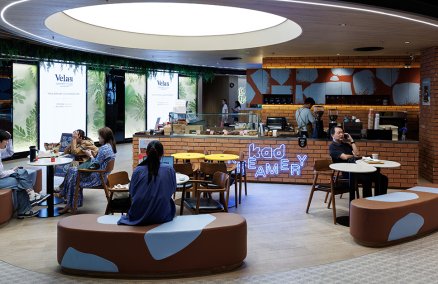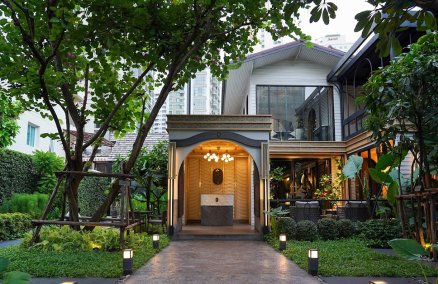THE HISTORY
The community around Mahakan Fort dates right back to the early Rattanakosin Era, during the reign of King Rama III (1824-1851). Those who lived on the banks of Khlong Ong Ang, many of whom were royal courtiers, built their homes next to the city wall at Mahakan Fort, one of the 14 forts which King Rama I built to protect the capital from the East side. By the Rama VI Era (1910-1925), all but two of these forts—Mahakan Fort and Phra Sumen Fort—had been torn down, while the original wall of the old city had shrunk from seven kilometers to 170 meters. Today, the remaining 100 meters of the six-meter-high wall which still stands around Mahakan Fort is listed as a National Heritage Monument by the Fine Arts Department.
THE DISPUTE
You can trace today’s conflict right back to 1959, when the government bought back land from around Mahakan Fort in an effort to preserve the fort and its surrounding area from all but 11 owners who refused to sell. The model scheme to create parks in the Rattanakosin area came later, in 1978, followed in 1992 by the BMA’s royal decree to improve Rattanakosin’s urban planning—including the expropriation of land on which the Mahakan Fort community lived. The BMA says that all of the land owners and some of the tenants took the money which the BMA offered them and moved away from the area while others stayed. It was only in 2004 that the Office of the Council of State granted the BMA powers to remove settlements from the land, including the century-old wooden houses.
In 2005, Apirak Kosayodhin, the Bangkok Governor of the time, signed a tripartite-memorandum of understanding (MOU) with Silpakorn University and the community’s leader to study alternative development solutions for the Mahakan community. Produced by Silpakorn University’s architecture instructor, Chatri Prakitnonthakan, and released in 2009, the study was called "The research project for a master plan for the preservation and development of ancient wooden houses at Mahakan Fort," and offered a model scheme in which the park could exist alongside the community, which itself would act as a living cultural museum. Following its release, however, developments on the scheme went silent as the BMA insisted on sticking with the original plan to make a park.
Today, the BMA claims present community members have no original historical link to the area, since the original owners moved out when the BMA expropriated the land in 1992. The community, however, insist they are the descendants of families who lived in the area centuries ago, and who gave birth to a rich part of Thailand’s arts and crafts heritage that includes Phraya Petchpani likay, Thailand’s first musical folk drama performance. (This is actually where the area’s original name, Trok Phraya Petch, comes from.) Craftsmanship still exists in the area today, with locals making traditional-style birdcages and carving Rue Si Dud Ton (miniature statues of hermits).
THE FINAL CALL
On Mar 28, the BMA’s Public Works Department set a notice sign in front of the fort wall telling residents that they must relocate from the area by Apr 30. Now, conservationists, environmentalists, academics and other communities have come together to help save the area from transformation into a park.
VOICES FOR MAHAKAN
Sanon Wangsangboon
“I agree that Bangkok has a really sparse amount of public space compared to other cities. But Bangkok is also not like other cities. It has a dense concentration of old communities, so whenever you decide you want a new public space, that means it will affect one of these communities. The BMA just thinks about getting rid of people in order to create their vision of a beautiful city. But look at Saphan Lek market. Getting rid of that market has resulted in a deserted space next to the canal which has been of no help to the city whatsoever. If the Mahakan model proposed in 2009 were to be attempted, it could change Bangkok’s vision for public space development. The BMA should follow a development model which puts people first. Given this area’s long history, it truly is a living museum.”
Sira Leepipattana
“We appreciate that the BMA wants to add more green space to the city, but green space isn’t limited to building parks. You can’t just move people out and create an empty park. Mahakan Fort has the potential to be more than a lifeless park. I wish the BMA could come up with a better solution.”
Sudara Suchaxaya
“I don’t see any reason to turn this area into a park. There are lots of parks around Rattanakosin—Rommani Nart Park, for example, is right nearby. There’s also the potential risk that the park will become a dangerous spot since it’s hidden behind a high wall. Don’t forget that these people are not trespassing on the land—they’ve lived here for generations. They are the last stronghold of the original settlement in the Rattanakosin area. But I do think that if they are allowed to stay and act as a living museum, there must be changes. They must welcome visitors, share their cultural knowledge and clean the space up.”
VOICE OF THE COMMUNITY
Thawatchai Woramahakun
Mahakan community leader
Materialism has driven Bangkok’s development for so long. This has really changed the context of how the old city develops, with buildings replacing people. Just look at Ratchadamnoen Avenue. It has been transformed into a venue for administrative services. There are museums, libraries and exhibitions but it’s deserted—and it’s even worse at night time, when there are literally no people there. This is the consequence of the BMA’s approach to development. They want to get rid of the five oldest wooden houses in this area—homes which prove the heritage and age of this settlement. Why would a city, administration want to squander taxpayers money to destroy monuments of historical importance? Is it worth building something that doesn’t really benefit the people of the city? They are trying to say we have no original roots here, but I can show them evidences that we have lived here for generations, like old drum-making tools. Mahakan could be used as a model to help save other old communities under threat from new development from the coming of the MRT line. If the BMA really wants to develop in this way, Rattanakosin will turn into a Disneyland simply to make them money from foreigners paying an entrance fee.
VOICE OF THE BMA

Sakchai Boonma
Director of Land Acquisition Division, Department of Public Works
We must follow the decree to develop the area into a park otherwise we will be the ones who are breaking the law. This issue is not new. The BMA already gave the community the opportunity to relocate a long time ago. Just think about it this way: if the land had belonged to the private sector and not the BMA, would the community have survived for this long? The BMA paid compensation to all the original owners and some tenants who were willing to accept the money—despite it not being required for us to do so. Many of those who now live in the area are newcomers who relocated here without permission within the last few decades. As far as cultural value is concerned, the community does not really have any unique arts and craft skills passed through generations. Regarding the historical structures like old houses, we will let conservationists review and renovate them, but it’s impossible to allow the community to live there as the BMA’s tenants. We have no law to support this kind of rental on public land. To assist with the original Apr 30 deadline, we have set up “The Working Group on Developing Mahakan Fort Area,” headed by Bangkok’s governor, Sukhumbhand Paribatra, to smoothly handle the community’s removal. It will focus on supporting the community while relocating them by the middle of this year.
VOICE OF THE ALTERNATIVE
Chatri Prakitnonthakan
Associate Professor of Silpakorn University’s Faculty of Architecture
It’s true that the BMA needs to follow 1992’s royal decree but it’s not true that we can’t change the situation. In fact, if we look at history, there are many cases in which royal decrees were changed. I also see a degree of inequality in law enforcement. Government-backed projects often receive special legal treatment, like the new Supreme Court building—Rattanakosin construction regulations limit buildings to 16 meters tall, yet the government allowed itself to build a 32-meter-tall building. Recently, the Marine Department has also been eyeing changes to regulations governing rivers as the government promotes its River Promenade project. For Mahakan Fort, it has been 24 years since the decree came out, and there are many studies—not just mine—pointing out how the original park project does not fit with modern needs. The plot is dead space surrounded by a wall and the river, which does not make it a suitable or safe space for a park. There are two crucial groups that can change the situation now: the government’s Rattanakosin preservation committee and the cabinet. The committee is actually overlooking Rattanakosin policy. They can reconsider the plan and propose a new scheme to the cabinet, who can then state a new royal decree to help save the Mahakan community.
NUMEROLOGY

102
Households originally located in the Mahakan Fort community
56
Households still living on site
228
People living in the community
4 rai 3 wa
The total area covered by the Mahakan Fort community
1 rai
The land which the 2009 proposal allocates as a park
3 rai
The land which the 2009 proposal allocates for the community
FIVE COMMUNITY VOWS
After the 2009 plan to turn the area into a living museum, as proposed by Silpakorn University, the community proposed five rules for how it would live alongside the park. These are:
- The community will live within the park as a cultural tourist attraction, floating market in Khlong Ong Ang along with handicraft shops, vocational training and traditional performance.
- The community will take care of the park with the BMA’s technical support.
- The community will become a model showing how a community can live alongside Bangkok’s parks and watercourses.
- Bangkok will collect tariffs from the community.
- The community will take care of the park with day and night shifts without receiving payment.
FIVE PARKS IN THE RATTANAKOSIN AREA
1. Sanamluang
2. Saranrom Park
Credit Photo: Wikipedia
3. Rommani Nart Park
4. Nagara Bhirom Manage Park
5. Santichaiprakarn Park
Help save the community at Mahakan Fort by signing this
Change.org petition to stop their eviction.
Source: Rattanakosin Information Center, Muang Boran Journal, www.mahakanmodel.com, BMA































